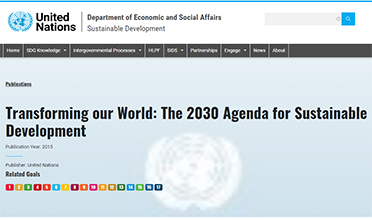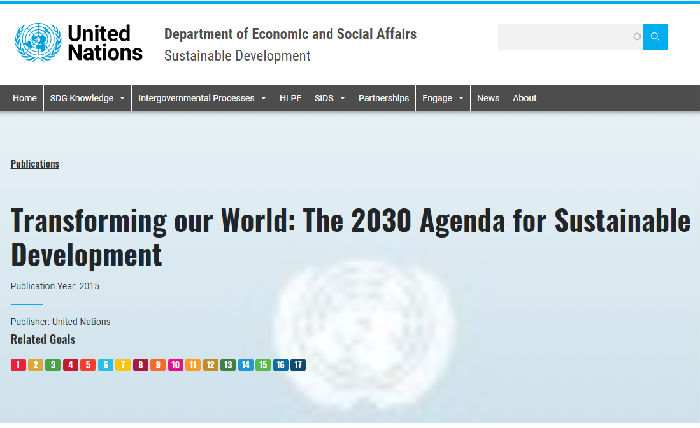


The New Urban Agenda, driven by the 2030 Agenda for Sustainable Development
The year 2015 marks the end of the United Nations Millennium Development Goals (MDGs) of 2000. Over the past 15 years, the MDGs have helped lift millions of people out of poverty, proving the effectiveness of their creation.
On September 25, 2015, the Sustainable Development Summit opened at the United Nations headquarters in New York, where more than 150 heads of state and government met to adopt a new agenda for sustainable human development. This is the "Transforming our world: the 2030 Agenda for Sustainable Development" (TASD).
The 2030 Agenda for Sustainable Development is a roadmap to end global poverty, build a life of dignity for all and leave no one behind, and contains 17 integrated, interconnected and indivisible Sustainable Development Goals (SDGs).
Goal 1. End poverty in all its forms everywhere
Goal 2. End hunger, achieve food security and improved nutrition and promote sustainable agriculture
Goal 3. Ensure healthy lives and promote well-being for all at all ages
Goal 4. Ensure inclusive and equitable quality education and promote lifelong learning opportunities for all
Goal 5. Achieve gender equality and empower all women and girls
Goal 6. Ensure availability and sustainable management of water and sanitation for all
Goal 7. Ensure access to affordable, reliable, sustainable and modern energy for all
Goal 8. Promote sustained, inclusive and sustainable economic growth, full and productive employment and decent work for all
Goal 9. Build resilient infrastructure, promote inclusive and sustainable industrialization and foster innovation
Goal 10. Reduce inequality within and among countries
Goal 11. Make cities and human settlements inclusive, safe, resilient and sustainable
Goal 12. Ensure sustainable consumption and production patterns
Goal 13. Take urgent action to combat climate change and its impacts*
Goal 14. Conserve and sustainably use the oceans, seas and marine resources for sustainable development
Goal 15. Protect, restore and promote sustainable use of terrestrial ecosystems, sustainably manage forests, combat desertification, and halt and reverse land degradation and halt biodiversity loss
Goal 16. Promote peaceful and inclusive societies for sustainable development, provide access to justice for all and build effective, accountable and inclusive institutions at all levels
Goal 17. Strengthen the means of implementation and revitalize the Global Partnership for Sustainable Development
Global Partnership for Sustainable Development
Chinese President Xi Jinping attended the UN Sustainable Development Summit and delivered a speech to the General Assembly, comprehensively articulating China's views on global development issues, proposing a development concept with equity, openness, comprehensiveness and innovation as core elements, and demonstrating China's strong determination to implement the post-2015 development agenda. The post-2015 development agenda is a task list of high standards and a heavy commitment, Xi said. "One point is deployed, nine points are implemented." I advocate that the international community strengthen cooperation and work together to implement the post-2015 development agenda and strive for win-win cooperation.

The website of 2030 Agenda for Sustainable Development
Sustainable Development Goal 11 of the 2030 Agenda for Sustainable Development is to build inclusive, safe, disaster-resilient and sustainable cities and human settlements. It includes:
11.1 By 2030, ensure access for all to adequate, safe and affordable housing and basic services and upgrade slums
11.2 By 2030, provide access to safe, affordable, accessible and sustainable transport systems for all, improving road safety, notably by expanding public transport, with special attention to the needs of those in vulnerable situations, women, children, persons with disabilities and older persons
11.3 By 2030, enhance inclusive and sustainable urbanization and capacity for participatory, integrated and sustainable human settlement planning and management in all countries
11.4 Strengthen efforts to protect and safeguard the world’s cultural and natural heritage
11.5 By 2030, significantly reduce the number of deaths and the number of people affected and substantially decrease the direct economic losses relative to global gross domestic product caused by disasters, including water-related disasters, with a focus on protecting the poor and people in vulnerable situations
11.6 By 2030, reduce the adverse per capita environmental impact of cities, including by paying special attention to air quality and municipal and other waste management
11.7 By 2030, provide universal access to safe, inclusive and accessible, green and public spaces, in particular for women and children, older persons and persons with disabilities
11.a Support positive economic, social and environmental links between urban, peri-urban and rural areas by strengthening national and regional development planning
11.b By 2020, substantially increase the number of cities and human settlements adopting and implementing integrated policies and plans towards inclusion, resource efficiency, mitigation and adaptation to climate change, resilience to disasters, and develop and implement, in line with the Sendai Framework for Disaster Risk Reduction 2015-2030, holistic disaster risk management at all levels
11.c Support least developed countries, including through financial and technical assistance, in building sustainable and resilient buildings utilizing local materials
Source:
_biz=MzAwMzM5OTE2Mw==&mid=2652587169&idx=1&sn=ad1b6501911734e2582c0c5ef6e1732c&chksm=80d42835b7a3a123b3bcc4c52c89439f81
e8a63732a43654845a06028240a1bd8b3a0bddf433&scene=27#wechat_redirect>
Translated by Chen Yan